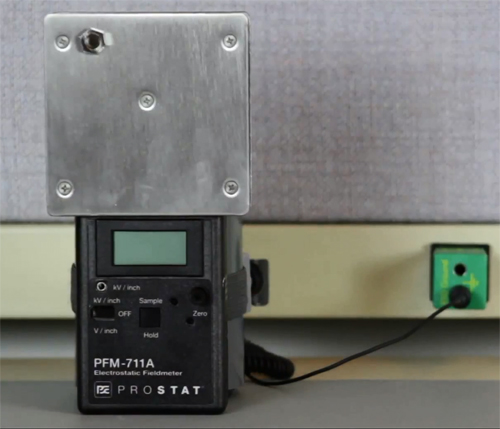Should you multiply decay measurements made with a Charge Plate Monitor by 2 to meet the requirements of ANSI EOS/ESD S3.1?
Recently, a customer using a Charge Plate Monitor asked an interesting question regarding the Prostat CPM-720A Charge Plate Monitor. Since it is stated that the CPM720A capacitance is approximately 10pF, does any direct decay measurement made with the CPM-720A should be multiplied by a factor of two (2) in order to match the requirements of ANSI EOS/ESD S3.1?
The capacitance of the CPM-720A by itself is 10pF. When mounted to the PFM-711A Field Meter, its capacitance increases to 15.6 to 15.9pF. How do we know this? We charge the plate to a known voltage (V), then discharge it to a nanocoulombmeter to measure its charge (Q), then calculate its capacitance (C) as in Q=CV and C=Q/V.
You do not multiply decay time by two (2). The correlation to a 20pF plate depends on several factors:
- The output in nanoamps of the ionizer you are measuring
- The distance from the ionizer
- Grounded objects nearby
- Fan speed
- Temperature & Humidity
At 12 inches the correlation of the CPM-720A to a lab level 6 inch plate at 12, 18 and 24 inches are as follows:
table here:
Thus, the comparisons are fairly close to 1 depending on distance and how you handle the instrument. “Mounted” means the unit was held in place while mounted to a 5 lb. electrode and grounded via a PWS-601M wrist strap.
For this reason, we are implying that the size of the charge plate would not affect the measurement. However, we need to understand the conditions of that implication. I am providing information that indicates at the distances tested with the equipment used, the differences are insignificant in an audit situation. The facts are that every instrument, CPM, ionizer and operator combination will produce different results under different conditions with different ionization equipment. There is no absolute constant. Why? Because an ionizer producing 60 nA output at 18 inches from a CPM will perform differently than an ionizer having 15 nA output at 18 inches, and at other distances both ionizers will perform in another way. Thus the decay times measured using different CPM’s – in some cases even the same CPM — or different ionizers will be different to some degree. There are no absolutes – just too many variables.
That being said, when measuring the same Simco ionizer at the same distance and conditions with a Prostat CPM-720A 3.25” plate and field meter having a C of 15.9 pF, and comparing that measurement to a Prostat CPM-760A 6” Charge Plate using the same field meter and having a C of 20 pF, the differences are insignificant. (See http://www.prostatcorp.com/collapsible-charge-plate-monitor-assembly).


Recent Comments